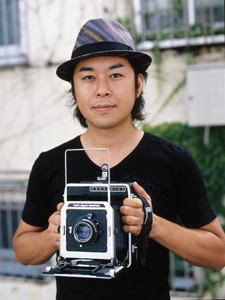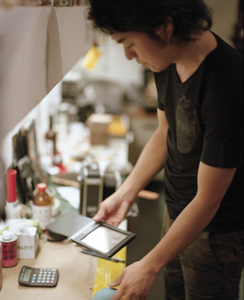Arai Takashi: a Daguerreotypical Man
by Ry Beville

Arai Takashi carefully removes a silver-plated copper slide from some tissue. He secures it in a small wooden frame that snaps into place over another wooden box. The hollow box is elevated over a small glass lamp that he lights, producing a thin blue flame to heat mercury. As the dangerous fumes lift up into the box, he closes the glass door to his hand-made machine, steps back and waits, his mind, it seems, in another world. His studio is a cross between an alchemist’s cluttered medieval lab and some swank office like you might see in San Francisco, New York or Berlin. Across the long wall is a shelf with the expensive tomes of photography greats. Janis Joplin is playing in the background. “Do you often listen to Janis when you work?” “No, just today. Sometimes it’s rock. Sometimes it’s punk.” Arai’s all-black wardrobe of well-worn clothes hints at his taste in music and there are streaks of green in his hair from what looks like dye highlights having worn off after some occasion where he had to fit the role. But if Arai is punk—if he is anti-establishment—it’s certainly not where his photography has taken him: to its very origins. The daguerreotype, named after its French inventor Louis Daguerre, was not the first photographic process. Daguerre’s colleague Joseph Niépce had used asphaltum on copper plates rubbed with lavender oil to produce images in a camera obscura with a multi-hour exposure in the 1820s. Photosensitive materials, like silver nitrate, had been realized, in fact, as early as the 13th century. But when Daguerre accidentally broke a mercury thermometer in 1835, thus discovering a way to develop images exposed for much shorter times, he unlocked its commercial potential. He made it available to the everyman, which accounts in large part for its legacy today. Daguerreotypes fell out of favor fairly quickly, in part because of their toxicity, and because of technological advances leading to simpler methods—like tintypes and eventually print photography. But before turning its back on mainstream needs and making its long march to relative obscurity, the daguerreotype process left behind a wealth of stunning images highly valued by historians and collectors. Today, there are probably fewer than a hundred people still practicing the process and Arai reckons he is the only one in Japan. With digital photography’s ascendancy assured, at least until hologram makers become commercial, Arai’s pursuit of daguerreotypes does seem kind of punk. And nostalgic. And, when you see the process and the resulting images, rather inspiring, too. “An old love interest in college had a camera and that sparked my interest in photography. It was more than ten years ago, before digital had really taken off, and I was using a film camera to take black and white shots. I started buying all kinds of old cameras. A Contax with a Zeiss lens was my first. I was studying biology but decided to enroll in trade school to learn photography. They taught us all the basics and practical things about photography but I believed you really had to go to the beginnings to understand the tradition. I started studying daguerreotypes in private at home in my kitchen.” Arai bought “A Step by Step Guide to Alternative Photographic Printing Processes,” a book available in English. Luckily he had attended the International Christian University, where classes where all in English; otherwise, he admits, he would have hit a wall. No literature on the subject was available in Japanese. Arai notes that he also relied heavily on the internet, where all the information was in English. “The very first time I made a daguerreotype, I was utterly impressed by its beauty. I thought, this must be a lie. It’s too simple a process to capture an image so wonderfully. The resolution is quite high, close to high-tech digital, actually. Old photographs turn brown, but if you look at dagerreotypes, they are still very sharp. The sharpness of the image depends on the plate, not necessarily the lens of the grain of the paper.” The silver plates used in the process need to be buffed, and that can take as long as an hour for each 8×10 plate Arai uses in his Speed Graphic camera. He describes it as a zen-like activity that he gives his full concentration while using a special, hand-made polishing brush. The 6×6 plates for his Hasselblad take less time of course, and are also a little more affordable– at ¥18,000 a plate. “When I was a student, I didn’t really have much money for them, but it’s not as if you’re taking lots of shots all the time. Maybe one picture a day, and you can re-use the plates if you mess up.” Arai shows me a mess-up, a portrait of an elderly woman in a park, “Her face is too dark.” The successful plates are magical to look at. You have to tilt them back and forth in light for the proper angle to view them, but when it’s right, the image suddenly appears: some cherry trees, city rooflines, portraits. Tsunami wreckage. Since 3/11 Arai has been traveling to the Tohoku region monthly to record the devastation there. Rubble tourism has become an industry and there is hardly any dearth of photography of the wrecked coastline. It’s hard to know Arai’s motivations. It seems to be an unarticulated recognition of the connection between such a monumental tragedy and the importance of capturing the world in its passing. As tearful survivors combed the destroyed remains of their homes and towns for mementos, photographs were among the most precious things recovered for many. Volunteer teams set up make-shift recovery centers in gyms, where countless photographs were brought to be restored or repaired. Thousands of people buried or cremated photographs instead of bodies. Daguerreotypes are fragile. A casual finger swipe can destroy the image. And yet, they’ve managed to survive. Thanks to Arai, a little more of this passing world will survive with them. Ghostly silver, they are perhaps the real color of memory. Arai Takashi’s images will be on display at the Kawasaki City Museum until October 10th. |
新井卓は銀メッキを施した銅板を慎重に取り上げると、それを木箱の表面に作られた小さな木枠の中に注意深く固定した。中が空洞になっているその木箱を微かな青白い炎を燃やしているランプで熱することにより水銀が熱せられる。有毒な水銀蒸気が木箱の内部に立ち昇ってくると彼はその自家製の木箱に付いているガラス窓を閉じ、一歩離れたところで精神を集中しながらしばらく待った。 彼のスタジオは昔の錬金術師の仕事場のようでもあり、見方によってはサンフランシスコやニューヨーク、あるいはベルリン辺りの街中にある洒落たオフィスのようでもある。長い壁には棚が備え付けられており、その棚には有名写真家たちに関する研究書が並んでいる。BGMにはジャニス・ジョプリンが流れていた。 「ジャニス・ジョプリンはよく聴くんですか?」 「いや、今日はたまたまです。ハードロックやパンクも聴きます」 着るものは黒を基調とした古着が多いということも音楽的な趣味と通じる部分がありそうだし、仕事上のイメージ作りからか、彼の髪の毛にはグリーンに染めたラインが何本か入っていた。彼がもしパンクロック好きだとしたらそれは彼が魅了されているダゲレオタイプという古典的な写真技法のイメージとはずいぶんかけ離れた印象だ。 発明者のルイ・ジャック・マンデ・ダゲールに因んで名付けられたダゲレオタイプは厳密には世界初の写真技法というわけではない。ダゲールと同時期に写真技術の研究を行っていたニセフォール・ニエプスという人物がラベンダーオイルを擦り込んだ銀メッキ銅板の上にアスファルトを塗ったものを感光剤として用い、長時間の露光時間を経てカメラ・オブスクラの画像を得る、ヘリオグラフィという方法を1820年代に開発している。硝酸銀などが感光剤となることはすでに13世紀に発見されている。しかしダゲールが1835年にたまたま水銀温度計を破損したことがきっかけとなり、ヘリオグラフィよりもはるかに短い露光時間で画像を得る技術を発明し実用性が飛躍的に高まったことにより、今日ではダゲレオタイプが世界最初の実用的写真技法であるとされている。 しかし画期的だったダゲレオタイプの人気も長くは続かなかった。処理に使うケミカルの毒性が強いこと、鉄板写真法の登場、さらにプリント写真といったより手軽な方法が開発されていったからである。しかしダゲレオタイプは忘れ去られてしまうまでに多くの価値ある写真を残し、それらは今日写真史家やコレクターの間で珍重されている。 現在ダゲレオタイプを用いている写真家は世界でもおそらく100人に満たず、日本では新井が唯一ではないかと思われる。デジタルカメラが普及している現在、新井のダゲレオタイプに対する情熱は反体制、パンクロックの精神を思わせる。ダゲレオタイプはノスタルジックである。そしてその手順も出来上がった画像も大変興味深いものだ。 「大学時代に付き合っていた女性がカメラを持っていて、それがきっかけで写真に興味を持つようになりました。もう10年以上も前のことですが、まだデジタル全盛になる前で、僕は当時フィルムカメラでモノクロ写真を撮っていました。そのうちに色々な中古のカメラに興味を持ち始め、最初に買ったのがツァイスレンズが付いたコンタックスでした。大学では生物学を学んでいたのですが、写真を勉強するために職業専門学校に入り直しました。そこで写真の基礎と技術を学びましたが、写真技術の伝統を理解するためにはその黎明期までさかのぼってみることが必要だと思いました。僕は周りに内緒でダゲレオタイプについて自宅の台所で勉強し始めました。 新井は”A Step by Step Guide to Alternative Photographic Printing Processes”という洋書を購入した。幸いなことに彼は国際基督教大学に通った経験があり、そこではすべての講義が英語で行われていたので英語には強かったが、そうでもなければ洋書を買っても理解できず行き詰っていただろうと言う。ダゲレオタイプについて日本語で書かれた専門書は当時無かった。また、インターネット上の英語の専門サイトも大変役立ったという。 「初めて自分でダゲレオタイプの写真を現像した時、その美しさに感動しました。何かの間違いかと思ったほどです。このくらいの手間でこんなに素晴らしい画像が得られるのかと思いました。解像度はデジタルに匹敵するレベルでした。写真は古くなるとセピア色に変色してしまいますが、ダゲレオタイプは昔に撮られたものも変色することなく鮮明な画像を保っています。鮮明な画像は銀板を使っているからで、必ずしもいいレンズや高品質のフイルムに頼らなくても鮮明な画像は得られるのです」。 銀メッキを施した銅板は平らに磨き上げる作業が必要で、新井が愛用しているスピードグラフィックカメラに取り付けられるこれら8x10サイズの銀板の研磨には1枚当たり1時間を要するという。特製の研磨ブラシで銀板を磨く作業は大変な集中力を要するらしく、新井の言葉を借りればそれは坐禅を組む時の精神集中のようだという。6x6判のハッセルブラッドは銀板の研磨に要する時間は短くて済み、銀板1枚当たりの値段も18,000円と、比較的手頃だという。 「学生の身分には高い買い物ですが、毎日何枚も撮るわけではなく1日1枚くらいのペースですし、撮影に失敗した時の銀板は再生してまた使えるのです」。 新井は失敗作だという1枚を見せてくれた。公園で年配の女性を撮ったものだったが「顔の部分が暗くなってしまいました」という。 一方、うまく撮れたダゲレオタイプはうっとりするような仕上がりを見せる。ちゃんと見るには光にかざして銀板を傾けながらきれいに見えるアングルを探さなければならないが、正しい角度にくるときれいな画像が突如現れる。桜の木、市中の建物のルーフライン、人物像、大津波の傷痕、などを見せてもらった。 3・11以降、新井は毎月のように東北地方を訪れ、惨状を記録してきた。被災地を興味本位で訪れる人も多く、東北の沿岸部の惨状はこれまでにも多数撮影されてきた。新井が現地を訪れるのはどんな動機からだろう?歴史的大惨事であったこと、消えゆく世界を記録することの重要性に対する意識が強いということだろうか。 がれきの中から見つかる写真が犠牲者たちの貴重な遺品となったケースは多い。ボランティアたちによってがれきの中から見つけ出された多くの写真が洗浄、修復されて現地の体育館などに並べられた。これまでに何千という人たちが行方不明者の写った写真を埋葬したり火葬したりしたという。 ダゲレオタイプは取り扱いが難しい。指が直接触れただけで画像が壊れてしまう。それでもダゲレオタイプは現代までなんとか生き残ってきた。そして新井のような写真家のおかげでこの移りゆく現在がダゲレオタイプの形で記録され将来に伝えられてゆく。ダゲレオタイプの特徴である淡い銀色、その色はもしかしたら思い出の真の色なのかもしれない。 新井卓の作品を展示した「ダゲレオタイプ 修復と表現 展」が川崎市市民ミュージアムにて10月10日まで開催中。 
|








